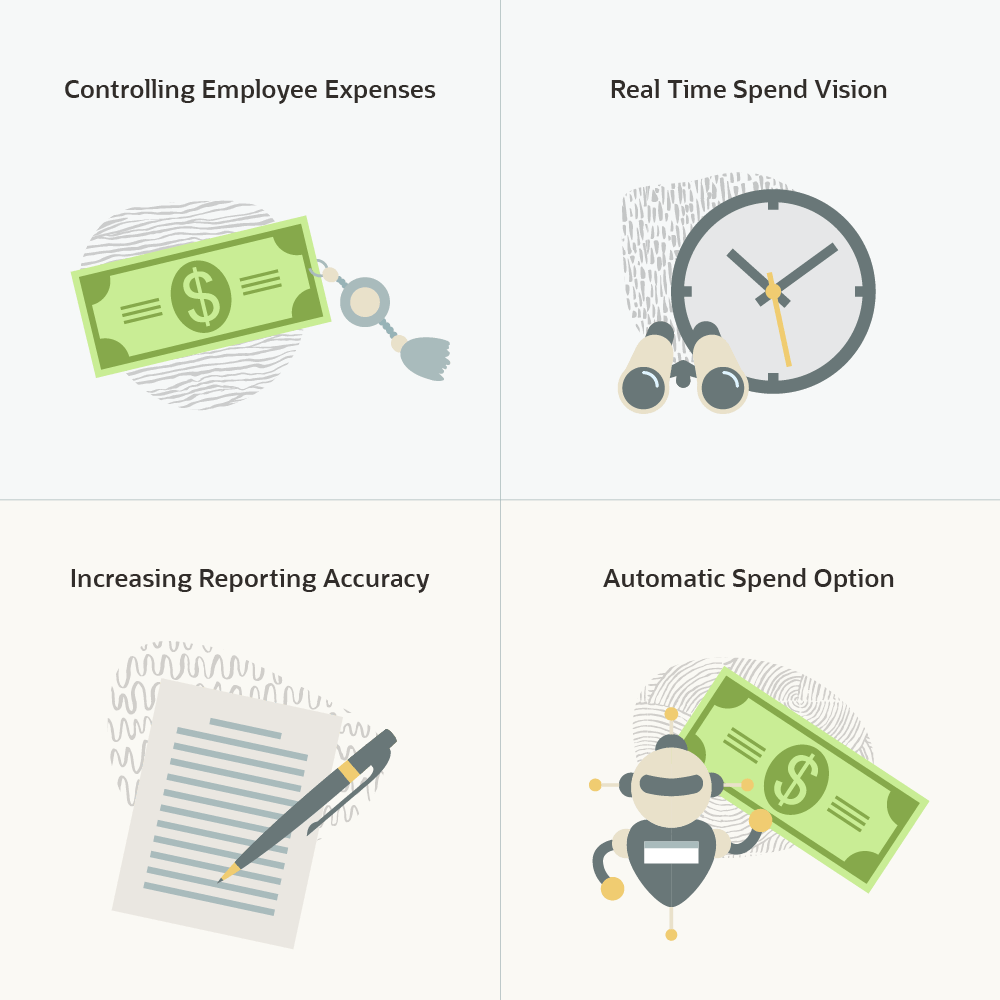Business leaders tend to focus on revenue growth as the most desirable path to success. But fast- and slow-growing companies alike can benefit by pursuing across-the-board spending efficiencies that save money, time and resources — all of which free capital and people to pursue increasing revenue for the long run. A key tool that companies have begun using to ferret out such cost-savings opportunities is business spend management, a set of software-supported business practices that unifies an organization’s view of all the disconnected ways it spends money and then subjects that spending to deep analysis.
What Is Business Spend Management (BSM)?
Business spend management (BSM) refers to a set of business practices, supported by software, that are used to track, manage and analyze enterprise-wide supplier relationships and expenditures, such as striking big-ticket contracts with key vendors, purchasing everyday office supplies and out-of-pocket travel expenses. BSM integrates and automates spending-related activities that previously were executed through multiple software tools. The objective of BSM is to maximize value from company spending while lowering costs — especially procurement costs — mitigating financial risk and improving relationships with suppliers.
Spend management vs. expense management. The system that companies use to process, pay and audit employee expenses is referred to as expense management. When members of the team pay for work-related items out of pocket, a good expense management system will ensure they are paid on time and in full. Spend management is a broader financial term referring to the company’s big-picture approach to how, when and why money is spent. So, while BSM incorporates employee expense management, it also encompasses procurement, invoicing, outsourcing and supply chain management.
Key Takeaways
- BSM illuminates mistakes and inefficiencies so that businesses can realize more value from their spending and vendor relationships.
- By aggregating and digitizing anonymous external company data (aka “community” data), BSM not only streamlines procurement processes but also makes organizations smarter and more accountable about how they spend money.
- BSM teaches that when it comes to saving time and money, the little, consistent actions can truly improve outcomes in the long run.
Business Spend Management Explained
BSM consolidates the processes of sourcing, contracting, purchasing and managing suppliers, invoices, employee expenses and payments into one automated process carried out on a cloud-based platform. This enables a business to gather and analyze all spending data and make more informed and insightful spending decisions.
With BSM, processes are automated, which eliminates unnecessary human error and frees up the labor force for higher-value activities. When spending data has been collected, cleaned and categorized, it can be analyzed to identify ways to lower costs and streamline procurement. Properly organized spending data helps the business operate more efficiently, flexibly adapting to changes in supply and demand.
Why Is Spend Management Important?
As businesses scale, they often must combine legacy systems with new ones to address ancillary processes, eventually building an unwieldy network of accounting tools that don’t collaborate well with each other. BSM harnesses spending data from many sources within that network and puts it to work for the business in ways that add up over time.
Those ways include, but go well beyond, saving money. Insightful reporting on spending helps a company save money by surfacing ways to be more efficient with that spending. The savings can then be allocated to more productive activities. Organized expense data provides transparency into ways to spot and cut costs that could have larger implications as the business continues to grow. Thinking further, BSM can be a boon during tax season because tracking and documenting expenses is crucial to avoiding penalties and maximizing tax breaks — or preparing for an audit. Moreover, when suppliers are paid on time and in full, they are happy partners to the business, which can result in favorable pricing, discounts and other long-term savings.
What Are the Origins of Business Spend Management?
BSM’s evolution has followed a pattern similar to that of enterprise resource planning (ERP), customer relationship management (CRM) and human capital management (HCM) systems. In each case, information technology solutions first arrived to address specific, narrow pain points of manual business processes, like managing sales contact information, database marketing and post-sales customer support in the case of CRM. Many such point solutions were eventually integrated into more comprehensive CRM systems, which by dint of their integration created more value than the sum of their parts.
Similarly, BSM evolved out of an era when all businesses relied on manual methods or simple tools, like spreadsheets, to manage their spending. These manual methods are time-consuming and prone to human error, so with technological advancements like the advent of automation, businesses began adding systems to manage their spending, such as accounts payable, employee expense management and procurement systems.
BSM emerged in recent years to unify those spending management systems. Serving as a “command center” for supplier records and financial control, BSM illuminates mistakes and inefficiencies so that businesses can realize more value from their financial processes and vendor relationships. These tools all work together to track data, curtail risk, save money and reduce complexity.
Spend Categories for Businesses
Over the course of a company’s life span, various costs will occur, some regular and recurring, some occasional or in response to changes in the business. But all of this spending can be categorized in two important dimensions: operating versus non-operating and fixed versus variable. The first category indicates whether the cost relates to the company’s core business, and the second describes whether the expense type fluctuates with production and service volume.
Every business expense is either operating or non-operating and either fixed or variable. And every subcategory listed as an example in the four bullets below can be separately tracked and analyzed with BSM.
- Operating costs: Operating costs are the ongoing expenses incurred from the normal day-to-day running of a business. Included in this category are the direct costs of goods or services sold (COGS) and other selling, general and administrative (SG&A) expenses. For example, rent and maintenance fall under this category, as does payroll, insurance, advertising, marketing, raw materials and depreciation.
- Non-operating costs: Non-operating costs are business expenses unrelated to core operations. Interest charges, taxes, impairment charges and losses on the disposition of assets fall into this category.
- Fixed costs: Fixed costs refer to expenses that don’t vary with an increase or decrease in the number of goods sold or services provided. They must be paid regardless of specific business activities. Fixed costs are generally indirect, in that they don’t apply to the production of goods or services. Examples of fixed costs include office and warehouse rent and the salaries and benefits of full-time employees.
- Variable costs: A variable cost is a company expense that fluctuates in proportion to how much a company produces or sells. Variable costs rise as production increases and fall as production declines. Examples include raw materials, product packaging, business travel expenses, credit card transaction fees and shipping costs. In contrast to full-time salaries, which tend to be fixed, wages for seasonal employees vary.
Benefits of Spend Management
BSM’s primary benefit is to unify a company’s spending data into a single source for analysis that yields savings. But by aggregating and digitizing anonymous cross-company data from a company’s supply chain, BSM also streamlines procurement processes. This helps make organizations faster, smarter and more accountable about how they spend money. Some of the benefits of this approach to spending include:
- Improved productivity and efficiency: BSM saves teams a huge amount of time. The automation of procurement speeds up workflow and reduces human error, freeing employees to focus on higher-order activities that grow the business. BSM’s detailed, real-time spending analysis enables leaders to forecast spending scenarios, leverage trends found in spending data and benchmark internal performance, all of which contribute to scaling up the business.
- Stronger negotiations with suppliers: BSM systems gather large amounts of internal and external data about suppliers and therefore can make recommendations based on community intelligence. That helps procurement teams negotiate better deals with suppliers. For example, the system can surface warnings that other industry peers have experienced late or broken shipments from a particular vendor, or that the average spend on a particular commodity is typically 20% lower than what your company has been paying. Using data from the entire community, BSM tools provide alerts and recommendations that steer decision-making toward better options.
- Opportunities for cost savings: Capturing and categorizing spending data through BSM sheds light on how departments, roles and individuals are responsibly managing company spending. BSM software unlocks new areas for cost savings, for example, by revealing opportunities for consolidating vendors, helping employees stay within budget and catching fraudulent invoices before they are paid.
- Risk reduction: BSM software monitors transactions to keep track of vendors’ financial performance and credibility. By providing up-to-date visibility into suppliers, BSM mitigates potential threats to the organization. It also ensures compliance with internal control policies and external audit requirements to keep the business in good standing with regulatory bodies.
Spend Management Challenges
Managing spending takes time and effort. Without a BSM system to centrally monitor expenses, it is easy for inefficiencies to go unnoticed and organizations to leave themselves exposed. Here are the top challenges faced by businesses that want to manage spending more effectively — all of which BSM software is meant to address.
- Disorganization: Spending across divisions is managed by different leaders. Collecting disparate divisional data can be challenging in terms of navigating varying interests, attitudes and degrees of cooperation. Accounts of spending may be represented in different formats, making the information even more disorganized, incompatible and harder to understand and analyze. One result: Managers in different departments might need to purchase the same item but lack awareness of the possibility of getting a better price together.
- Data silos: Without BSM, different types of spending — supplier payments, employee expenses, IT services — are often tracked by disparate information systems. This creates data silos, where important information isn’t easy to find because it is scattered across multiple tracking systems that are often not interoperable.
- Lack of transparency: Some team members don’t want others overseeing how they spend company money. Some departments document expenses on paper only, making them hard to track and categorize. Reluctance to change with the times can lead to resistance in adopting new systems that are designed for maximum transparency.
- Manual processes: The more manual processes there are, the more potential for human error. Employees enter data incorrectly; finance teams copy information incorrectly. These issues compound over time into misguided decision-making, resulting in higher costs and missed opportunities for operational efficiencies.
- Insufficient resources: The capacity to collect and analyze spend data requires analytical skills, which can be expensive to hire and time-consuming to learn. An AI-powered analytical tool is helpful in making sense of the data.
Spend Management Approaches
The core of BSM’s value comes from its highly systematic approach to procurement. Depending on a company’s industry and the processes it already counts among its core competencies, it may benefit most by automating one or two subprocesses within procurement or the entire spectrum, from strategic sourcing to payment processing (aka “source to pay”). As applied to procurement, BSM comprises the following processes and subprocesses.
- Source to pay: Sometimes called S2P, source to pay is the full-spectrum procurement process, starting with identifying, vetting and selecting suppliers. Purchasers at an organization look for products with a level of quality that meets their needs, proper pricing and vendors that can meet the company’s expectations in terms of timeliness, openness to change, etc. The next steps are negotiating and establishing contracts, placing orders, collecting deliveries, accepting invoices and settling them with payments. S2P gives business leaders visibility into the entire procurement process; improves an organization’s process, regulatory and contractual compliance; improves collaboration and trust among supply chain participants; and helps organizations obtain better pricing.
- Source to contract: Like S2P, source to contract begins with sourcing products or services from a competitive set of vendors. The business’s requirements are analyzed, documented and shared with potential vendors, and quotes are gathered from them. The contract is awarded to the vendor that best matches the business’s requirements and provides the most promising quote. A contract is negotiated, then, once signed, the source-to-contract subprocess ends.
- Invoice to pay: Paying an invoice may at first seem too simple a process to be improved much by IT automation. But depending on the business, accurately assessing and paying invoices can involve a series of critical steps — including matching the invoices to contracts, orders and accepted or rejected deliverables — and then one or more approvals. As a business grows, automating this subprocess can provide important efficiencies for a business’s accounts payable team.
- Procure to pay (also known as procure to invoice): The procure-to-pay subprocess integrates the purchasing department with the accounts payable department in order to create greater efficiencies. Unlike S2P, it does not include the function of sourcing vendors. Procure to pay includes requisitioning, purchasing, receiving, paying and accounting for goods and services.
Spend Management Tools
Spend management tools are the crucial part of BSM software that track and manage non-payroll business expenditures, such as the cost of raw materials, marketing services and even industry-specific magazine subscriptions. This software is used to gain insight into spending across the entire company by collecting and analyzing expense data. It can help avoid overspending and assure that an organization’s business-related expenses are accurately accounted for in financial statements.
Thus, BSM software is used by procurement departments to plan and monitor business expenses, but it is also used by accountants for financial reporting purposes. Not to be conflated with expense management software, which only focuses on employee expenditures like taxi rides, meals or business travel, spend management software integrates with procurement software and supply chain solutions like supply chain planning software and sales and operations planning software. It typically provides a centralized repository of procurement and purchasing data, includes rules and workflows to approve purchases and payments, and analyzes historical data to identify trends and make recommendations for savings.
4 Key Areas for BSM to Improve Spend Management
BSM software helps finance managers and accountants more effectively manage how their companies spend money by gaining better visibility into expenses as they’re incurred. This leads to better control of employee spending, improved reporting accuracy and, ultimately, optimizes the organization’s bang for its bucks. Here’s a deeper look at how.
- Real-time spend visibility: It isn’t easy to analyze spending or build a strategy to manage it without complete knowledge of organizational purchasing, especially for smaller companies with small finance departments. Without BSM software, controllers must hunt down financial information from emails, billing statements, paper receipts and other distributed sources of information. With BSM, an organization can centralize cash flow management into a single platform in real time; finance team members can log in and see every transaction as it happens, forecast spending and correct wasteful behavior.
- Controlling employee expenditures: Without BSM, employees submit expense reports after making a purchase, sometimes weeks or months later. Controllers don’t find out about out-of-policy spending until after the fact, making it much harder to address. With BSM, businesses can consistently enforce policies, set personalized credit card parameters and controls, and prompt requests for pre-approval before purchases are made.
- Increasing reporting accuracy: To manage spending effectively, companies need reports that accurately reflect their financial state of being. Without BSM, reports often have incomplete or faulty data, which leads to less effective forecasting. Manual data entry leads to errors, delayed submission of expense reports throws off quarterly accounting and a lack of financial acumen on the team can lead to weak or little data analysis. BSM software uses machine-learning algorithms to organize and digest data and draw out insights and connections that highlight cost-saving opportunities.
- Automatic spend optimization: In small companies and teams, no one has time to painstakingly chase down expense inconsistencies, like missing documentation, or pursue every possible savings opportunity. BSM software automates workflows, reducing the tasks employees would otherwise spend hours doing manually. For example, employees are prompted via email or text message to submit receipts for expenses at the point of purchase, or they’re informed of better contracted prices when ordering supplies. This data is automatically matched to the transaction in the software so there are no lost receipts or guesswork about which expenses they belong to. By creating rules for vendors and specific categories that automate spend management, spending can be automatically optimized.

3 Spend Management Strategies to Adopt
New processes and technology have adoption hurdles to overcome. People resist new methodologies unless careful strategies are chosen to see them through. With BSM software, the easier it is to learn and the smoother it is to adopt, the faster the new tool will show results and the more likely it will be to fall into common practice among employees. These three strategies increase the odds of such a positive outcome.
-
Establish a spend management policy for all procurement and employee expenses: When deploying BSM, it’s important to pair it with a comprehensive, enforceable and fair expense policy that applies to everyone at the organization. It is crucial that everyone at the organization understands spending procedures — money and time are wasted if people repeatedly make the same mistakes. Even something as seemingly small as purchasing office supplies or reimbursing an employee taxi ride can add up over time if employees do it wrong. A comprehensive expense policy helps ensure compliance and minimizes the risk of fraud and unnecessary expenses.
The biggest challenge of integrating new technology is team member buy-in, so be sure to educate everyone at the company on how to identify, establish and track spending. This creates a cost-conscious culture and empowers employees to look for cost-cutting opportunities.
-
Develop a reliable reporting system: Employees are more likely to comply with policy if the reporting allows them to submit reports, receipts and documents with ease. When employees use advanced spend management software to capture pictures of their receipts or process expense reports on the go, they will turn around their reports faster, and the data can be used to inform future spend decisions. A tool with robust analytical features will help finance teams identify trends and gain useful insights to help address spend management process gaps.
-
Simplify spend management with automation: An automated spend management system simplifies the work processes of employees, their supervisors and the accounting team by minimizing tedious email communication, paperwork and supplier confusion. Automation speeds up collaboration and tracks spending more efficiently, allowing everyone to get more work done, streamline business processes and bring in more revenue.
Features of Spend Management Software
The most crucial features of BSM software are the big-picture ones already discussed: the increased transparency of spending data that comes from integrating information across the many ways the business spends money, the depth of analysis that enables spending optimization and the automation that lets organizations handle tasks faster and more efficiently. But there are many other key features that are “closer to the ground,” like expense report creation and tracking, that enable the big-picture features.
For example, real-time expense tracking helps companies keep a tight leash on employee expenditures by tracking each one as it happens — with no surprises at the end of the month. Multiple payment options builds positive relationships with suppliers. Easy retrieval of essential documents like invoices, receipts and POs streamlines record keeping and due diligence.
Choosing the Right Spend Management Software
Businesses choosing among the available BSM software options should consider their spending needs first. Ask questions like what types of expenses will be managed by the software, what payment methods the business uses and how many payments can be made in a month. Make sure the software you choose accommodates your spending requirements and habits.
Look for a cloud-based solution for a more seamless flow of data. Employees will be able to access and upload information on the go. Ensure the software supports mobile devices so that workers have options as to the device they use to submit expenses. Look for real-time tracking and analysis.
In addition, advanced features like auto approvals and pre-approvals save you and your employees’ time. They also provide visibility into spending and approvals.
Manage Your Spend With NetSuite
NetSuite customers can choose from among multiple spend management options to find the ones that best suit their needs. For example, NetSuite Procurement includes a feature that can centrally manage a company’s purchase order to approved suppliers and pore-negotiated contracts, offering real-time views into company spend and vendor performance throughout the produce-to-pay process.
BSM brings businesses benefits that enhance their competitiveness, such as minimizing financial waste, mitigating risks and leveraging employee time and effort for more strategic work. With BSM, managing and optimizing company costs doesn’t have to be difficult or laborious because spending information is integrated across all of a business’s spending silos, centralized and normalized for in-depth analysis and insights that lead to improved spending efficiency.
Business Spend Management FAQs
What is a spend management company?
Spend management is a set of practices that ensure organizations make procurement and sourcing decisions in the interests of both the bottom line and company efficiency. A spend management company has developed and sells spend management software systems and has the implementation know-how to make that software work effectively for different companies.
Why is business spend management (BSM) important?
BSM is important to companies because it provides a level of transparency and control over spending that can be used to reduce risk, drive business growth, increase profits and optimize operational efficiencies.
What is managed spend?
Managed spend is any spending under contract, meaning a transaction in which a company’s procurement team has been involved in sourcing and negotiating the terms. Unmanaged spend is any spend that occurs outside of a company’s defined procurement cycle.
What is a spend management strategy?
Spend management strategy is the planning, process and system of managing business spending, including procurement, supply chain management and outsourcing.









